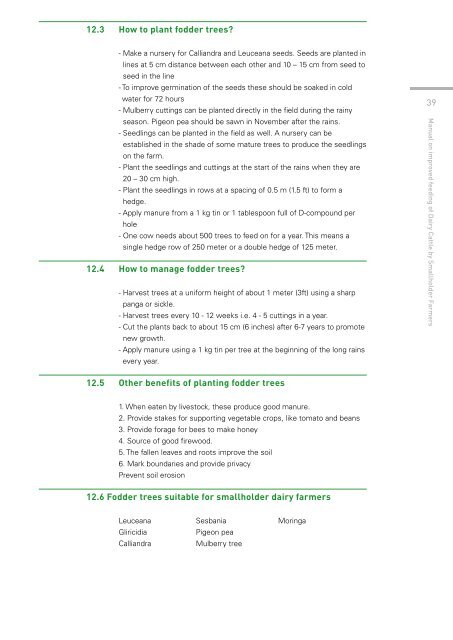MANUAL ON IMPROVED FEEDING OF DAIRY CATTLE BY ... - Gart
MANUAL ON IMPROVED FEEDING OF DAIRY CATTLE BY ... - Gart
MANUAL ON IMPROVED FEEDING OF DAIRY CATTLE BY ... - Gart
Create successful ePaper yourself
Turn your PDF publications into a flip-book with our unique Google optimized e-Paper software.
12.3 How to plant fodder trees?<br />
- Make a nursery for Calliandra and Leuceana seeds. Seeds are planted in<br />
lines at 5 cm distance between each other and 10 – 15 cm from seed to<br />
seed in the line<br />
- To improve germination of the seeds these should be soaked in cold<br />
water for 72 hours<br />
- Mulberry cuttings can be planted directly in the field during the rainy<br />
season. Pigeon pea should be sawn in November after the rains.<br />
- Seedlings can be planted in the field as well. A nursery can be<br />
established in the shade of some mature trees to produce the seedlings<br />
on the farm.<br />
- Plant the seedlings and cuttings at the start of the rains when they are<br />
20 – 30 cm high.<br />
- Plant the seedlings in rows at a spacing of 0.5 m (1.5 ft) to form a<br />
hedge.<br />
- Apply manure from a 1 kg tin or 1 tablespoon full of D-compound per<br />
hole<br />
- One cow needs about 500 trees to feed on for a year. This means a<br />
single hedge row of 250 meter or a double hedge of 125 meter.<br />
12.4 How to manage fodder trees?<br />
- Harvest trees at a uniform height of about 1 meter (3ft) using a sharp<br />
panga or sickle.<br />
- Harvest trees every 10 - 12 weeks i.e. 4 - 5 cuttings in a year.<br />
- Cut the plants back to about 15 cm (6 inches) after 6-7 years to promote<br />
new growth.<br />
- Apply manure using a 1 kg tin per tree at the beginning of the long rains<br />
every year.<br />
12.5 Other benefits of planting fodder trees<br />
1. When eaten by livestock, these produce good manure.<br />
2. Provide stakes for supporting vegetable crops, like tomato and beans<br />
3. Provide forage for bees to make honey<br />
4. Source of good firewood.<br />
5. The fallen leaves and roots improve the soil<br />
6. Mark boundaries and provide privacy<br />
Prevent soil erosion<br />
12.6 Fodder trees suitable for smallholder dairy farmers<br />
Leuceana Sesbania Moringa<br />
Gliricidia Pigeon pea<br />
Calliandra Mulberry tree<br />
39<br />
Manual on improved feeding of Dairy Cattle by Smallholder Farmers


